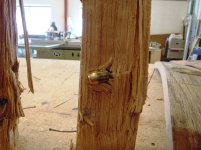You are using an out of date browser. It may not display this or other websites correctly.
You should upgrade or use an alternative browser.
You should upgrade or use an alternative browser.
Penetration tests for the heavy 357 magnum rounds?
- Thread starter Lambdebois
- Start date
riverrat38
New member
"Dried and dead... It was scrap from a $9,000 door my buddy made for some castle up in snowmass village..."
$9000, well, no wonder there were no knots. This was obviously very select wood. That would give the most consistent results.
I have often wondered about doing tests like this one. I put penetration above expansion for handguns, and think that this test gives better information than jello. I am more concerned about getting through the hard stuff than the wound channel in tissue. The bear or whatever is probably more like oak than jello! I tend to think that expansion is more valuable to fast, small, rifle bullets than heavy, slow, handgun ammo.
Thanks for sharing the results with us, and keep up the good work.
rat
$9000, well, no wonder there were no knots. This was obviously very select wood. That would give the most consistent results.
I have often wondered about doing tests like this one. I put penetration above expansion for handguns, and think that this test gives better information than jello. I am more concerned about getting through the hard stuff than the wound channel in tissue. The bear or whatever is probably more like oak than jello! I tend to think that expansion is more valuable to fast, small, rifle bullets than heavy, slow, handgun ammo.
Thanks for sharing the results with us, and keep up the good work.
rat
458winshooter
New member
357 heavies
And here I thought I was the only one who wondered about this subject.I can't make up my mind whether to purchase a Lyman mold #358430 or try to get Lee to help me make a 200gr tumble luber.
And here I thought I was the only one who wondered about this subject.I can't make up my mind whether to purchase a Lyman mold #358430 or try to get Lee to help me make a 200gr tumble luber.
Lambdebois
New member
Here is a shot of the DT 147gr 357sig round still in the second board. Both DT's and BB's 357 sig bullets had very little deformation and only just really at the nose. No noticeable expansion either. The BB did go slightly further though.
Is DT using a 9mm 147 gr Montana gold bullet?
I am curious as to the 125gr fmj Buffalo bore it using also because as I said earlier.... The flat point or metplat..... was much smaller than any other 357 sig bullet I've shot. I am not familiar with Hornady's tmj bullet though....
Is DT using a 9mm 147 gr Montana gold bullet?
I am curious as to the 125gr fmj Buffalo bore it using also because as I said earlier.... The flat point or metplat..... was much smaller than any other 357 sig bullet I've shot. I am not familiar with Hornady's tmj bullet though....
Attachments
Last edited:
warningshot
New member
44 Magnum puts the 357 to shame
It isn't even close.
Look for an early, black & white, to mid 1970s handloader annual type magazine. Inside you will see some men punching holes thru a 1955 Ford Fairlane rear bumper with a Smith 29. Hey, if it's in print it's true. Right?
I have personally 'kilt' many a landfill microwave, as well as all steel conventional, stove(s); as well as but limited too T.V.s, & steroes, speakers and turntabes, American and Japanese; refrigerators and freezers, stacked and conventional standing; air conditioning evaporators and condensors, pressure and non pressurized versions; water heaters; Detroit sheet metal from every Rust Belt manufacture riddled from numerous angles and distances; All...obviously... from under the watchful eye and in strict accordance with all state and federal safety guidelines of course (yea, right).
You kids & Nannies out there, don't try this at home. We are the professionals.
Conclussion: The .357... can't /don't /never will/aint gonna...hold a candle to Mr. 44 Mag when it comes to penetration.
As to the Hog & shoulder penetration question: Are we talking a grain fed Kalifornia beast, or some East Coast Swamp critter? I have the medicine for both.
It isn't even close.
Look for an early, black & white, to mid 1970s handloader annual type magazine. Inside you will see some men punching holes thru a 1955 Ford Fairlane rear bumper with a Smith 29. Hey, if it's in print it's true. Right?
I have personally 'kilt' many a landfill microwave, as well as all steel conventional, stove(s); as well as but limited too T.V.s, & steroes, speakers and turntabes, American and Japanese; refrigerators and freezers, stacked and conventional standing; air conditioning evaporators and condensors, pressure and non pressurized versions; water heaters; Detroit sheet metal from every Rust Belt manufacture riddled from numerous angles and distances; All...obviously... from under the watchful eye and in strict accordance with all state and federal safety guidelines of course (yea, right).
You kids & Nannies out there, don't try this at home. We are the professionals.
Conclussion: The .357... can't /don't /never will/aint gonna...hold a candle to Mr. 44 Mag when it comes to penetration.
As to the Hog & shoulder penetration question: Are we talking a grain fed Kalifornia beast, or some East Coast Swamp critter? I have the medicine for both.
I'm not surprised the Buffalo Bore 180 grain round out penetrated the Double Tap 200 grain round. I've read about a lot of people chronographing Double Tap's ammo at around 10% lower than their stated velocities. Buffalo Bore lists their stuff's velocity through actual guns. I have a 6" GP100 so I feel pretty good about getting 1400 fps on the Buffalo Bore 180 grain round.

